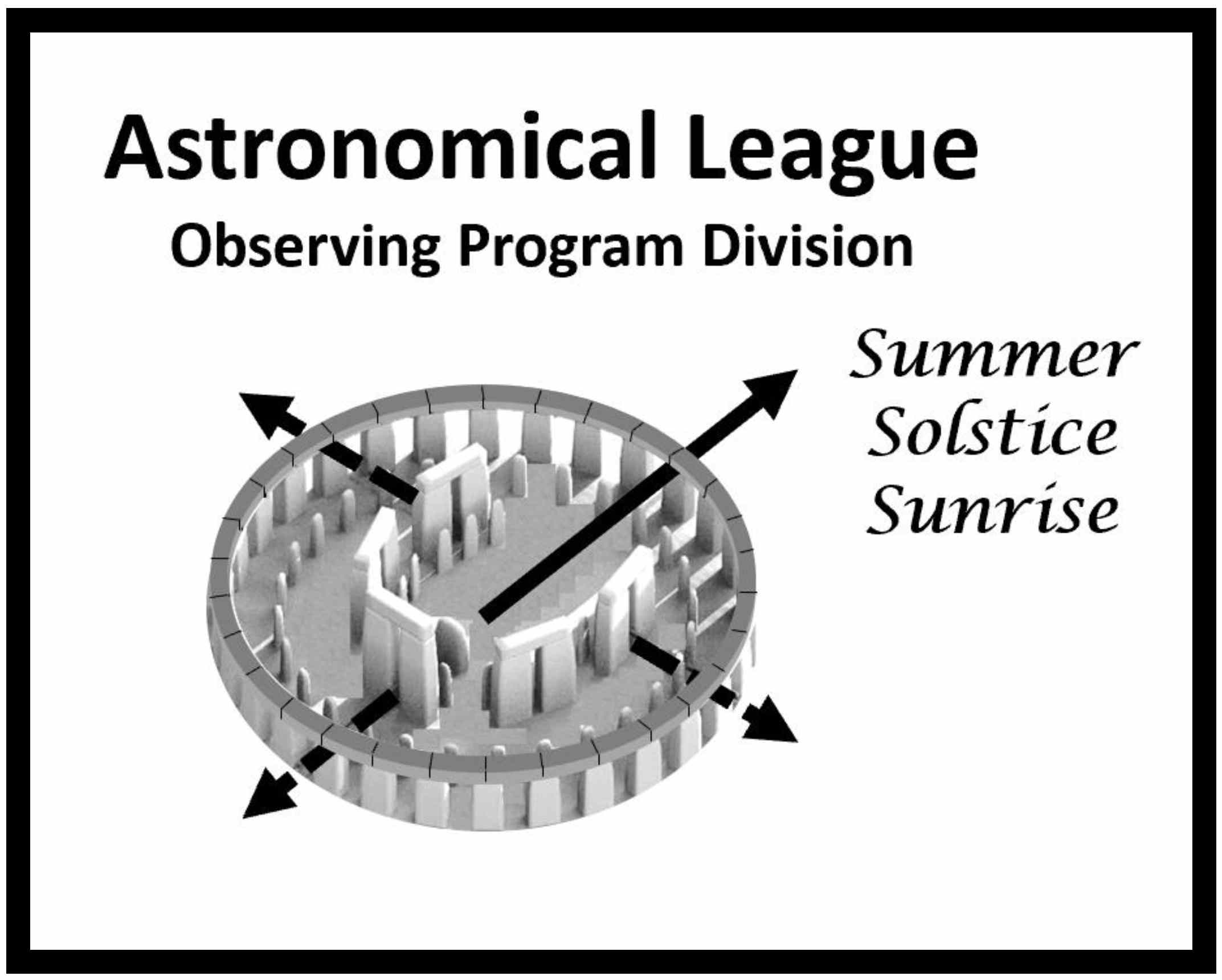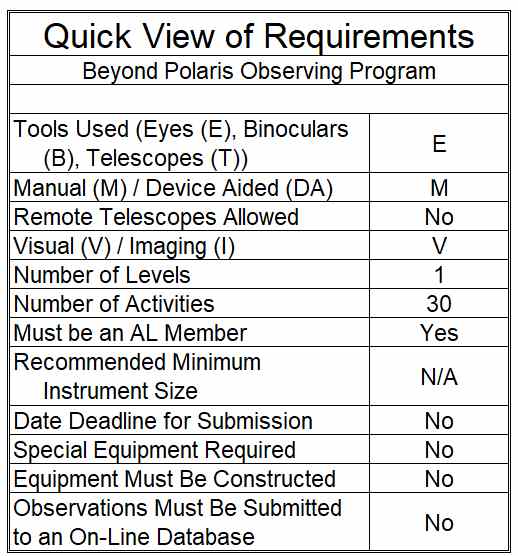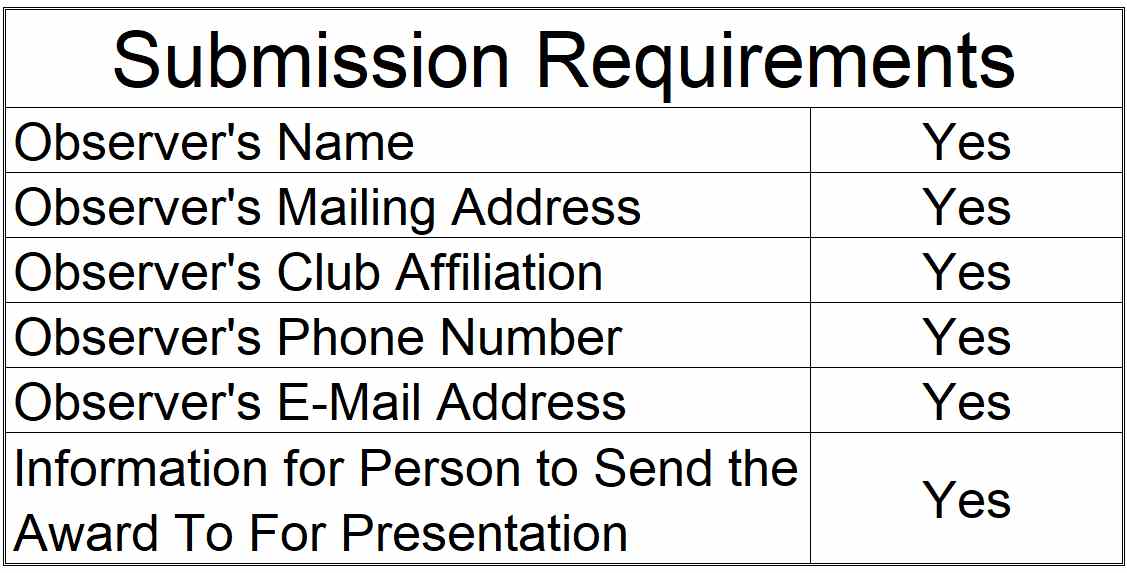Beyond Polaris Observing Program Coordinator:Maynard Pittendreigh
|
 |
Overview
| The Beyond Polaris Observing Program was designed for anyone who enjoys looking at the sky but has no astronomy background. Their main interest is to better understand the constellations and their stories, name a few stars and then to share this information with their family and friends. All the observations are accomplished with the unaided eye.
The program starts with some instructional information done inside at your kitchen table even on a cloudy night. Basic information on Star Party Etiquette, what supplies to take to your own Star Party, background review of the solar system, constellations, and the beginning of your astronomy vocabulary. (It is easy to get overwhelmed and lost within minutes of being around a few amateur astronomers when they start speaking words that a beginner has no idea of what it all means.) So we begin under electric light to begin with astronomy understanding and vocabulary, which will grow as you continue on your amazing voyage to learn about our sky. Beyond Polaris will then take you outside to teach you how to find the North Star in a couple of different ways. From there with the use of your planisphere, you will star hop around to a variety of constellations, stars, and asterisms while seeing an occasional meteor shoot across the sky. It is not only the dark nights full of stars; but also the bright light of the moon that you will learn about. In learning about the phases of the moon, you will learn what nights are best to see constellations and deep space objects. The moon will be amazing to you, your friends, and grandkids. |
 |
If we don’t all pull together to reduce Light Pollution we won’t be able to enjoy any of the above information. So there is a section on protecting our Dark Skies and how each of us can make a difference.
Background Information
The Beyond Polaris Observing Program was designed by Bridget Langdale, Suzanne Bjork and Wendy Hastings. They are with the Mason Star Gazers (MSG) located in Mason, Texas. The following is their story.
Beyond Polaris – Sky Observing 101 for New Amateur Astronomers
We are three women who were excited about the sky but had no previous knowledge or childhood references about astronomy. Books, and conversations with other amateur astronomers found us ‘lost’ very quickly since we were at the very beginning of learning in this field of astronomy. We were over the age limit of 11, too old to work the Sky Puppy Program, so we decided to create our own Program. No special equipment such as binoculars or telescopes was required. We outlined Star Party Etiquette and what to bring such as red flashlights.
After almost a year, we came up with this program and accomplished everything listed.
“Beyond Polaris has given me the confidence and focus on what I’m seeing in and around the Milky Way, which I can see in my backyard. It’s a program around storytelling. Knowledge to be shared with my B&B guests, friends, who sit in my star gazing tubs, seeing stars/Milky Way sometimes for the first time and ask what’s that over there?” – Bridget Langdale
“The benefit of this program has given me clarity in a way that is not intimidating and sparks interest in further study. Good first steps in the immense world of astronomy. The way it is designed it encourages solo and group study.” – Suzanne Bjork
“A good program to start with…now we are ready for more!” – Wendy Hastings
Requirements and Rules
This certification is available to members of the Astronomical League, either through their local astronomical society or as members at large. If you are not a member and would like to become one, check with your local astronomical society, search for a local society on the Astronomical League Website, or join as a Member-at-Large .
A. Basic Background Information
- Keep a log including notes of each requirement (observations and new knowledge).
- Acquire a notebook to keep your notes. This will not be submitted. Only a checklist is required to be submitted.
- Each entry should include the Date and Time.
- Observations should also include your observing location (Latitude and Longitude).
- Include an estimate of the Seeing and Transparency as well.
- Understand Star Party Etiquette & create your own Sky Kit (things to take to a star party):
- Write down a few items of Star Party Etiquette.
- List the items you included in your Sky Kit.
- Tell 2 mythical constellation stories.
- Include the dates you told the stories, audience information, and what constellations you chose.
- Research the Milky Way Galaxy, and what it should look like in the night sky.
- Document this in your log.
- Is it visible from your observing site?
- Draw a sketch of the solar system identifying the planets:
- Include the sketch and label all objects.
- Learn a unique characteristic about each planet:
- List each planet and one of its unique features.
- Explain the difference between an asterism and a constellation:
- Include the Date, Time, and the audience information.
- Include the definitions.
- Explain Binary Stars and Star Clusters (open and globular):
- Include the Date, Time, and the audience information.
- Include all three definitions in your log.
- What is the meaning of circumpolar?
- Include the definition in your log
- What is the Messier Catalog? Who was Messier and how many objects are in the list?
- Include the information in your log.
- What is a Nebula? (Emission and Reflection)
- Include both definitions in your log.
B. Looking at Stars & Constellations
- Draw by freehand 15 Constellations:
- Sketch the constellations and include their name as well as the proper names of any bright stars.
- Locate, identify and observe three constellations (Ursa Major, Ursa Minor, Cassiopeia, Leo, Orion, The Southern Cross, Cygnus, or others):
- Document those constellation observations in your log.
- Locate, identify and observe the North Star (Polaris) using other constellations (Ursa Major, Cassiopeia, The Summer Triangle, or Orion):
- Include a sketch and indicate how you located it.
- Locate and observe two planets in the night sky.
- Document those planets in your log.
- Demonstrate the use of a Planisphere.
- Include the audience in your log.
- Locate, Identify and observe major stars and other objects in 15 constellations.
- Include the constellations identified in your log.
- Locate, identify, and observe 1 deep space object with the unaided eye (M45 – the Pleiades, The Hyades in Taurus, M42 – the Orion Nebula, M44 – the Beehive in Cancer, M41 in Canis Major).
- Include the object and the name of its constellation in your log.
C. The Moon
- Sketch the seven phases of the moon.
- Include sketches and label them in your log.
- Locate, identify and observe three Moon Maria (seas).
- Include the maria in your log.
- Sketch the Man, the Rabbit, and the Woman in the Moon.
- Include the sketches in your log.
- Explain Lunar Eclipses and Solar Eclipses and draw diagrams.
- Include the sketches in your log.
- Also, include the audience information.
- What is the definition of the Terminator (on the Moon)?
- Include it in your log.
D. Meteor Showers, Shooting Stars, Falling Stars, Zingers
- Understand the definitions and the differences between Meteoroids, Meteors, and Meteorites.
- Include the definitions in your log.
- Identify 3 major Meteor Showers and the dates when they occur.
- Include this information in your log.
- Include the source you used to get this information in your log.
E. Protecting our Dark Skies
- Evaluate your personal property related to reducing Light Pollution.
- Document your findings in your log.
- Learn about Watts, Lumens and Kelvin (color) of light bulbs.
- Include the definitions in your log.
- Educate others on the importance of proper and appropriate outdoor lighting. Include the value of Dark Skies and proper lighting to cost savings, wildlife, human health and enjoyment of the sky.
- Document this in your log.
- Include the audience information.
F. Future Planning:
- Document in your log information about the next star party that you plan to attend.
- Review the Astronomical League Observing Programs.
- Identify the programs that you think would make good started programs for you to pursue.
- Document in your log information about your choice of an Observing Program to pursue
Submitting for Certification
You do not need to submit your log book. Use the checklist to note when you complete each activity. A COPY of this checklist should be submitted to the Observing Program Coordinator, An electronic copy in an email is encouraged. This information must also be provided:
|
 |
Upon verification of your submission and of your active membership in the Astronomical League, your recognition (certificate, pin, etc.) will be sent to you or to the awards coordinator for your society, as you specified. Your name will also appear in an upcoming issue of the Reflector magazine and in the Astronomical League’s online database. Congratulations. Good luck with your next observing challenge.
Beyond Polaris Observing Program Coordinator:
Maynard Pittendreigh
1281 Serena Drive
Winter Park FL 32789
Telephone: 321-400-4312
E-mail: Maynard@Pittendreigh.net
Resources:
- The checklist webpage
- Downloadable Checklist in MS Word format, PDF format



